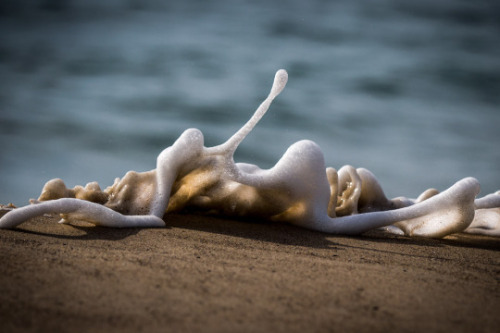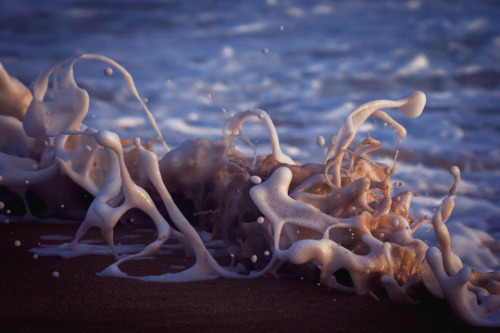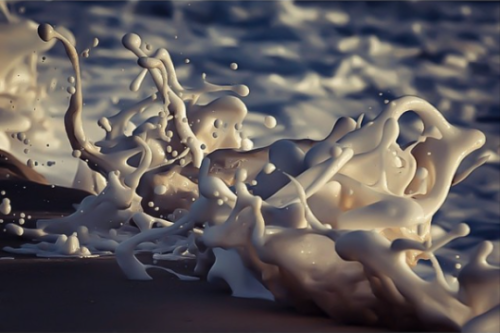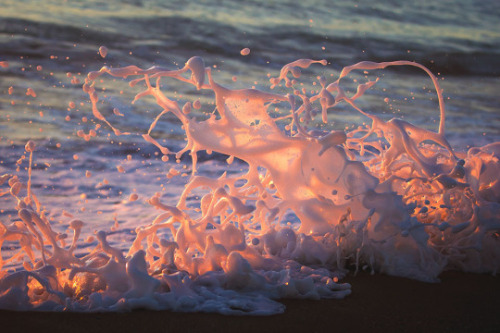Photographer Lloyd Meudell Captures Surrealistic Images Of Breaking Sea Foam. Interestingly, The Sea




Photographer Lloyd Meudell captures surrealistic images of breaking sea foam. Interestingly, the sea foam is essentially a three-phase fluid made up of air, water, and sand. Yet despite the surrealism of its forms, the foam bears strong resemblance to other flows. The shapes the foam forms are reminiscent of vibrated non-Newtonian fluids like paint or oobleck. Momentum deforms the foam into sheets and ligaments smoothed and held together by surface tension until droplets snap free. You can find more of Meudell’s work at his site. (Image credits: L. Meudell; via freakingmindblowing; submitted by molecular-freedom)
More Posts from Sohmygodness and Others

My best friend and I had a call recently—she’s back with her family for a bit helping out with some hometown stuff. As part of the stuff, she’s been going through a (deceased) relative’s scrapbook, compiled in the American Midwest circa 1870-1900 and featuring mostly cut-out figures from the ads of the day.
She talked about how painstaking this relative’s work was. (Apparently the relative was careful to cut out every finger, every cowlick; this was by no means carelessly or hastily assembled.) But she also she talked about how—the baby on the baking soda ad is ugly, it is so ugly, why anyone would clip this heinously ugly illustrated baby and paste it into a scrapbook? Why would you save the (terribly told, boring) ghost story that came with your box of soap?
(Why include these things in the first place? we asked each other. ”There’s a kind of anti-capitalism to it,” she mused.)
And we discussed that for a bit—how most of the images, stories, artists, and ads were local, not national; they’re pulled from [Midwestern state] companies’ advertisements in [Midwestern state] papers, magazines, and products. As a consequence, you’re not looking at Leyendecker or Norman Rockwell illustrations, but Johann Spatz-Smith from down the road, who took a drawing class at college.
(College is the state college, and he came home on weekends and in the summer to help with the farm or earn some money at the plant.)
But it also inspired a really interesting conversation about how—we have access to so much more art, better and more professional art, than any time in history. As my bff said, all you have to do to find a great, technically proficient and lovely representational image of a baby, is to google the right keywords. But for a girl living in rural [Midwestern state] of the late 1800s, it was the baking soda ad, or literal actual babies. There was no in-between, no heading out to the nearby art museum to study oil paintings of mother and child, no studying photographs and film—such new technologies hadn’t diffused to local newspapers and circulars yet, and were far beyond the average person’s means. But cheap, semi-amateur artists? Those were definitely around, scattered between towns and nearby smallish cities.
It was a good conversation, and made me think about a couple things—the weird entitlement that “professional” and expensive art instills in viewers, how it artificially depresses the appetite for messy unprofessional art, including your own; the way that this makes your tastes narrower, less interesting, less open.
By that I mean—maybe the baby isn’t ugly! Maybe you’ve just seen too many photorealistic babies. Maybe you haven’t really stopped to contemplate that your drawing of a baby (however crude, ugly, or limited) is the best drawing of a baby you can make, and the act of drawing that lumpen, ugly baby is more sacred and profoundly human than even looking at a Mary Cassatt painting.
And even if that isn’t the case….there was this girl in [American Midwestern state] for whom it was very, very important that she capture every finger, curl, and bit of shading for that ugly soap ad baby. And some one hundred years later, her great-something-or-other took pains to preserve her work—because how terribly human it is, to seek out all the art we can find that resonates with us, preserve it, adore it.
It might be the most human impulse we have.

This night, I say the name of the knife that wounds me still:
your hand almost gentle on the hilt; desire sliding neat
between my ribs, skin bruising soft as the rot-sweet peach.
I am reaching now for the pit of my heart, I am praying to you again.
I surrender my grieving made offering, I hail the winter
giving graceless way to spring—beg forgiveness by that awful
reverence, which I offer both what I love and what I fear.
Ode to Goncharov (1973), Yves Olade


do you ever think about this quote by mary lambert because i think about it all the time

Flying Fish, 1910 - oil on canvas. ― Herbert James Draper (English, 1863-1920)

The Magpie, Claude Monet, 1868-69
Happy birthday, Claude Monet (Nov. 14, 1840 - Dec. 5, 1926).
Good Omens - summary/partial transcript of DVD audio commentary

I’ve done a summary and partial transcript of the audio commentary to Episode 1. You can find it here. I hope they’ll be helpful to those whose first language isn’t English, and to those who struggle with audio-only commentaries, plus there aren’t subtitles for the commentaries.
Similar summaries of the rest of the episodes will follow in due course, hopefully finished by the end of the week. Stay tuned - I’ll do another announcement once they’re all done.
Behold! Nice and Accurate Piano Adaptaion of Good Omens opening theme courtesy of my brilliant music theory teacher and dear friend Sergey Bogomolov. The version generally found online is obviously incorrect so l am incredibly greatfull for this edit. Also - can I hear a wahoo?



COVID is slowly becoming a "third world" disease. While first world countries are hoarding vaccines, having doses for populations many times their size, third world countries can't get any because pharma companies want to sell to the first world countries first. Even then, first world countries will receive them first. While rich countries recover from COVID, they will forget about the pandemic while many other countries live the absolute worst moment of the pandemic without being able to vaccinate their population.
-
 bethemagicyouwanttosee reblogged this · 1 month ago
bethemagicyouwanttosee reblogged this · 1 month ago -
 gayghost69 liked this · 1 month ago
gayghost69 liked this · 1 month ago -
 unbielevenary reblogged this · 1 month ago
unbielevenary reblogged this · 1 month ago -
 ogpenson reblogged this · 1 month ago
ogpenson reblogged this · 1 month ago -
 sand-in-my-shoes reblogged this · 1 month ago
sand-in-my-shoes reblogged this · 1 month ago -
 fingerstealer reblogged this · 1 month ago
fingerstealer reblogged this · 1 month ago -
 yourlocal-lichen reblogged this · 2 months ago
yourlocal-lichen reblogged this · 2 months ago -
 killer-curiosity reblogged this · 2 months ago
killer-curiosity reblogged this · 2 months ago -
 inversedictionary reblogged this · 2 months ago
inversedictionary reblogged this · 2 months ago -
 deathsmallcaps reblogged this · 2 months ago
deathsmallcaps reblogged this · 2 months ago -
 xosiren reblogged this · 4 months ago
xosiren reblogged this · 4 months ago -
 xosiren liked this · 4 months ago
xosiren liked this · 4 months ago -
 diveintakeabreath reblogged this · 5 months ago
diveintakeabreath reblogged this · 5 months ago -
 mynameisactuallylenny liked this · 6 months ago
mynameisactuallylenny liked this · 6 months ago -
 drummergirl345 reblogged this · 6 months ago
drummergirl345 reblogged this · 6 months ago -
 beziehungsstatuspizza reblogged this · 6 months ago
beziehungsstatuspizza reblogged this · 6 months ago -
 a-cosmonaut-or-an-astronaut liked this · 8 months ago
a-cosmonaut-or-an-astronaut liked this · 8 months ago -
 likadastuff liked this · 9 months ago
likadastuff liked this · 9 months ago -
 dionysiandragon liked this · 9 months ago
dionysiandragon liked this · 9 months ago -
 thepeaceofwildthings reblogged this · 9 months ago
thepeaceofwildthings reblogged this · 9 months ago -
 anirlfairy reblogged this · 11 months ago
anirlfairy reblogged this · 11 months ago -
 anirlfairy liked this · 11 months ago
anirlfairy liked this · 11 months ago -
 circe-diana reblogged this · 11 months ago
circe-diana reblogged this · 11 months ago -
 yyzzuu liked this · 11 months ago
yyzzuu liked this · 11 months ago -
 circe-diana liked this · 11 months ago
circe-diana liked this · 11 months ago -
 sohayass reblogged this · 11 months ago
sohayass reblogged this · 11 months ago -
 twerk4mammon reblogged this · 11 months ago
twerk4mammon reblogged this · 11 months ago -
 v3nusdoom reblogged this · 11 months ago
v3nusdoom reblogged this · 11 months ago -
 v3nusdoom liked this · 11 months ago
v3nusdoom liked this · 11 months ago -
 noah-makes-art reblogged this · 11 months ago
noah-makes-art reblogged this · 11 months ago -
 vlka-fenryka reblogged this · 1 year ago
vlka-fenryka reblogged this · 1 year ago -
 traveloracphotos liked this · 1 year ago
traveloracphotos liked this · 1 year ago -
 moosetracks11 reblogged this · 1 year ago
moosetracks11 reblogged this · 1 year ago -
 whydocowsfall liked this · 1 year ago
whydocowsfall liked this · 1 year ago -
 let-your-sword-do-the-talking reblogged this · 1 year ago
let-your-sword-do-the-talking reblogged this · 1 year ago -
 bisclavaret liked this · 1 year ago
bisclavaret liked this · 1 year ago -
 murdermitt3ns liked this · 1 year ago
murdermitt3ns liked this · 1 year ago -
 lindywitch reblogged this · 1 year ago
lindywitch reblogged this · 1 year ago -
 cyanocittta reblogged this · 1 year ago
cyanocittta reblogged this · 1 year ago -
 rorganized liked this · 1 year ago
rorganized liked this · 1 year ago -
 letsgetsketchin reblogged this · 1 year ago
letsgetsketchin reblogged this · 1 year ago -
 utterly-thrilling reblogged this · 1 year ago
utterly-thrilling reblogged this · 1 year ago -
 sohayass liked this · 1 year ago
sohayass liked this · 1 year ago -
 stufftodraw reblogged this · 1 year ago
stufftodraw reblogged this · 1 year ago -
 mabelaugusta liked this · 1 year ago
mabelaugusta liked this · 1 year ago -
 bittersweetbetween reblogged this · 1 year ago
bittersweetbetween reblogged this · 1 year ago -
 philomelodie liked this · 1 year ago
philomelodie liked this · 1 year ago -
 hewasafraid liked this · 1 year ago
hewasafraid liked this · 1 year ago -
 thesaxmachine liked this · 1 year ago
thesaxmachine liked this · 1 year ago